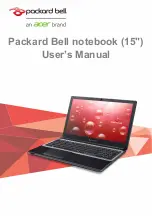
Glossary
179
Suspend
—A feature of some Windows
®
operating systems that allows
you to turn off the computer without exiting your open applications
and to continue from where you left off when you turn the computer
on again.
Swipe
—Swipe an open window to the left or right of the screen to
display the next or previous window.
system prompt
—The symbol (in the MS-DOS
®
operating system,
generally a drive letter followed by a “greater than” sign) indicating
where users are to enter commands.
T
TFT display
—See
active-matrix display
.
Tile/Tiles
—A list of square or rectangular icons on the Start screen
representing applications that can be accessed by selecting them.
U
Universal Serial Bus (USB)
—USB is a serial bus that supports data
transfer. USB allows hot swapping of peripherals. See also
bus, hot
swapping, serial.
upload
—To send a file to another computer through a modem or
network. See also
download
.
USB
—See
Universal Serial Bus (USB).
USB Flash drive
—A small, portable flash memory card that plugs into a
computer’s USB port and functions as a portable hard drive. They
are smaller and more durable than an external hard drive because
they do not contain any internal moving parts, but have less storage
capacity. See also
Universal Serial Bus (USB)
.
utility
—A computer program designed to perform a narrowly focused
operation or solve a specific problem. Utilities are often related to
computer system management.
W
Web
—See
World Wide Web
.
Wi-Fi
®
—A registered trademark term of the Wi-Fi Alliance that stands
for Wireless Fidelity, and is another term for the communication
protocol to permit an Ethernet connection using wireless
communication components.
World Wide Web (www)
—The worldwide network of Web sites linked
together over the Internet. A user of the Web can jump from site to
site regardless of the location of the computer hosting the site. See
also
Internet.








































